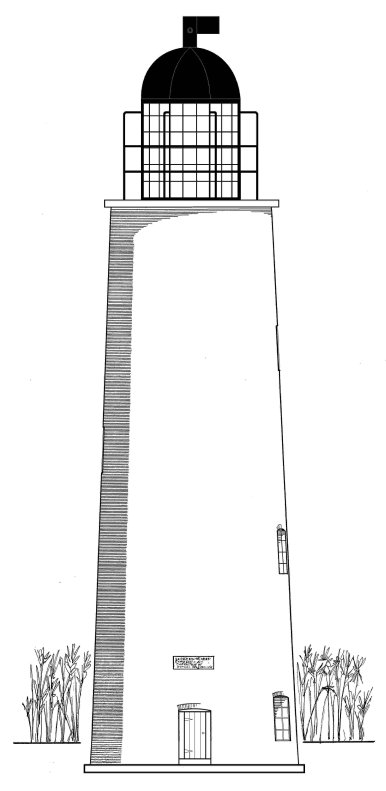You may have noticed a drawing of the 1823 Frank’s Island Lighthouse towards the top of the main page. One of the things that first drew me to the Frank’s Island Lighthouse was the aerial photograph of the tower ruins taken in 1995 by Bob and Sandra Shanklin. What intrigued me about the photograph was the fact that the lantern was missing. As I began researching the structure, I discovered that no known drawings or photographs existed which depicted a complete lantern. For the longest time, I questioned whether the original lantern had been reused or whether Lewis’ tower was capped with one of his signature “birdcage” lanterns. The photographs from Samuel Wilson’s 1935 report for the Historic American Buildings Survey show the remains of a railing system consistent with a “birdcage” lantern. A report from the 1855 U. S. Congressional Serial Set states that the “dome” was painted. Since the lantern from the first lighthouse was equipped with a stone cap, my conclusion based on these findings is that the 1823 lighthouse erected on Frank’s Island featured a “birdcage” lantern.
Once I came to this conclusion, I began searching for a scale drawing of a Lewis “birdcage” lantern. This was more difficult than I originally thought considering it has been noted that Lewis had a canned set of tower designs. I eventually discovered such a plan in David Cipra’s first book, “Lighthouses & Lightships of the Northern Gulf of Mexico” published for the Department of Transportation in 1976. This book is now out-of-print; but if you can locate a copy at a reasonable price, I would recommend purchasing it. There are pictures and information contained in this 62-page publication that were not included in his second book.
With scale drawings of both the Lewis’ tower and lantern in hand, I was able to overlay the two images in scale to generate a single image. I then projected the submerged base of the tower from Wilson’s drawing and added the remaining few feet at the bottom. The "Frank’s Island Lighthouse – 1823" drawing towards the top of the blog’s main page is the result. I hope this drawing serves to give future generations a fairly accurate representation of the lighthouse that stood at the Northeast Pass of the Mississippi River for 179 years.
Thursday, January 10, 2008
Subscribe to:
Posts (Atom)




